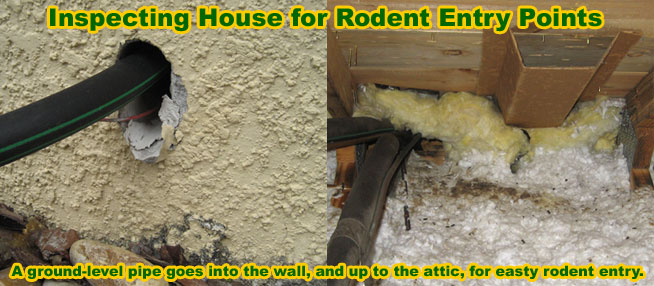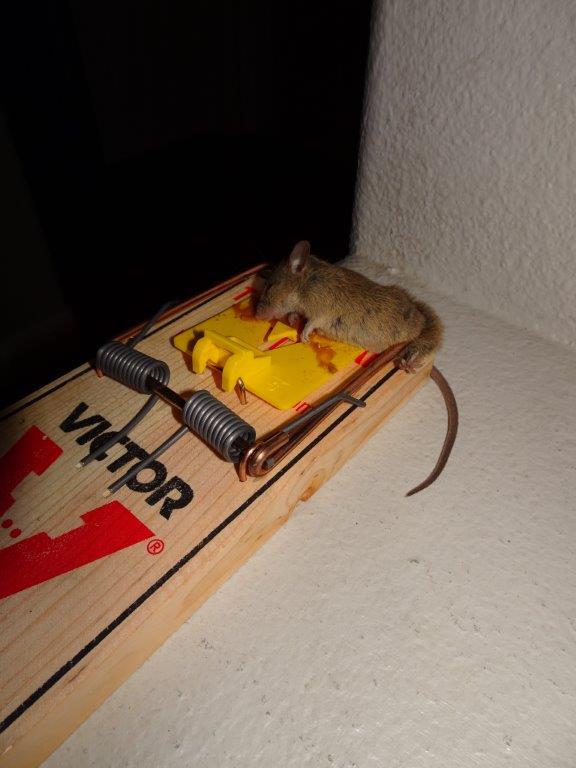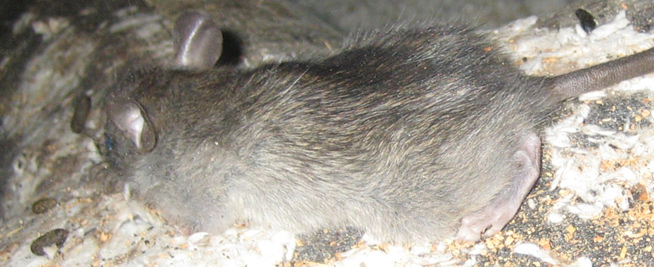Prevention is the best medicine (after penicillin, that is). Presumably you're at this website because you already have a rat problem,
but did you know that the below preventative techniques are essential to you solving your existing rat problem? Plus, you'll have
no more rodent issues in the future. Yay! Let's get started.

I guess the first thing that I'll say is that there's no way to keep rats from existing - that is, there's always going to be rats living outside. If you live in an urban or suburban area, you'll have rats. That's just the way it is. Where there's humans, there's rats. They easily find a way to survive. So really, what I'm talking about here is preventing rats from getting in your house, or attic, walls, crawl space, basement, commercial building, etc. In the above photo, you can see several types of entry points rats can use to enter a house. In a couple of the cases, rats have chewed open the entry holes. If areas such as these are sealed shut with reinforced steel screen, then rats can't chew their way in.
HABITAT MODIFICATION & PREVENTION
There's a reason you have rats on your property and in your house. Your property is in an area of the country that has a rat population (that includes most urban or suburban areas), and your property or house has features that are attractive to rats. Most commonly, this means that your property has food, water, and shelter. Rats like a safe place to live and scavenge and hide and have a nest of young and store food, and so on. A building makes a great location! It's warm and dry and safe, and in proximity to food, and so on. There's a reason rats are common in cities, but not out in the forest. Learn how to keep rats away, and take these rodent prevention steps:
- Eliminate debris such as garbage or compost piles on the property.
- Seal all gaps, with steel, leading anywhere into the house.
- Don't leave out pet food or open garbage cans.
- Bird feeders can attract rats, as can fruit trees.
- A pet cat or two might help. But I have seen rat infestations in homes with cats.
- Planting or spreading mint leaves - that's a myth.
- Use of rat repellants such as ammonia, mothballs, or cat urine.
- Use of ultrasonic sound emitters (proven fraudulent by the FTC).
- Use of fake owls or hawk decoys.
FIND OUT HOW THEY ARE GETTING IN! - SEAL ALL ENTRY POINTS!
Okay, this is the most important prevention concept: don't let them get into the house in the first place. We don't mind so much if the rats are outside, doing their thing, minding their own business in the dark hours of the night, but
when it comes to getting inside our houses, scurrying up the walls, pooping in the attic, raiding the pantry and contaminating our homes, that's where we draw the line. So prevent that from happening! Seal up all the entry holes. There
are dozens of areas rats can use to get in: vents, eaves, roof joints, plumbing stacks, AC chases, the chimney, soffit vents, loose siding, pipe outlets, etc. Any hole the size of a quarter will do. In the below photograph, there's an
insulated pipe leading outside and up the wall. It goes right into the walls of the home and up into the attic. Talk about easy for the rats! Holes like this one are a rat magnet. They should be sealed at once.

I seal entry points like these by bolting in steel mesh or metal (such as aluminum) flashing. I then use a polyurethane sealant to stop the air flow - that's important, because rats detect air flow, and if they can smell a gap open on the other side of a hole, they work hard, they chew, to get their way in. I seal up all vents with steel screen.
As stated earlier, if you have a current rat problem, and need to solve it, outside of just prevention, you need to do these home repairs to keep rodents out. Otherwise, rats will just keep coming and going into your house, and you'll never solve your current rat problem. So get cracking on those preventative repairs! If you don't have a good understanding of rat behavior, if you don't have a good understanding of building architecture, if you lack the tools to fix the home, the ladders to reach all the roof openings, the safety equipment and know-how, then I do definitely advise that you hire a professional to do a complete preventative rat-proofing of your house.
I've written more on my how to keep rats away page. If you want help, I have friends that I have personally trained in these cities: AZ - Phoenix - CA - Los Angeles - CA - San Diego - CA - San Francisco - FL - Fort Lauderdale - FL - Jacksonville - FL - Miami - FL - Orlando - FL - Tampa - GA - Atlanta - IL - Chicago - OR - Portland - NC - Raleigh / Durham - OH - Cleveland - PA - Philadelphia - TX - Austin - TX - Dallas - TX - Fort Worth - TX - Houston - TX - San Antonio - WA - Seattle - Washington DC - Essex UK
WILL A CAT OR DOG HELP?
Cats are superior to dogs when it comes to catching rats. But even several pet cats that are skilled hunters will not guarantee to solve a problem with rats in your house. I have been to many rat jobs at households that have many cats, and outdoor cats. Rats are very good survivors, and when they have a house to live in, cats and dogs can't solve the problem. Read more about can dogs keep rats away.
THE SAME APPLIES TO MICE
Although I wrote this site with rats in mind, such as the Roof Rat and Norway Rat, the same principles apply to other rodents, such as the house mouse. Mice behave very similarly to rats, they're just smaller. Email me if you have any questions about how to prevent a mouse from getting in your house, mouse prevention, how to prevent mice in your attic or walls, or any rodent prevention matters.

Home remedies to keep away rats and get rid of them
There are many reported ‘repellents' or ‘deterrents' that are reported to drive rats away, and keep them away, but the majority of them just don't work. They're also pretty dangerous. Do you know what happens when you inhale ammonia, for example? This is one of the most commonly used rat repellents, and we cannot recommend it as a rat removal method at all. It's not pleasant, let me tell you that, with the fumes being both toxic and corrosive. It causes massive irritation to the respiratory system - threat and nose, and also the eyes, and it didn't take much to cause a reaction. That's why you shouldn't use something as dramatic as ammonia when trying to get rid of rats, and other wild animals also.
Also: do you know the right concentration of ammonia you would need? Or where to put it? Or how long to leave it there for? Or what to do afterwards? Ammonia - it actually causes more problems than it solves.
Moth balls are no better, to be honest, although at least you'll be keeping the moths at bay when you use them. In our ten years of experience, moth balls have rarely worked to keep rats, or any other wild animal, at bay. These home remedies just don't work. When they have worked, it's been down to sheer fluke, or usually because of another method of rat removal and prevention that has been used at the same time. Moth balls just don't do anything for a rat. They might not like the smell of them, but that wouldn't be enough to keep a female rat from making a comfortable spot in your home her nesting spot. This is very much the case for any repellents or deterrents you come across, for any wild animal too. These days, in the fight to find your place in this world, it really is dog-eat-dog. If a rat had found a safe and cosy spot, she won't give it up. Not without a fight anyway. It's best you save your money, or better yet, spend it on something that might actually work to repel these creatures. Exclusion devices and methods are something we would personally advise, and that's a tried and tested way to get rid of rats that we've successfully been using for over a decade. It deals with all aspects of the problem at once - sealing up holes, cracks, crevices, and repairing all areas of damage or weakening of your home, in order to stop these critters from ever getting in again. If you don't do that, your home will always be a soft spot for invading wild animals, and soon it won't be long before a few rats are your problem. What are you going to do when you come face to face with a skunk? Or an opossum? How about a raccoon? What about bats in the attic? By using exclusion methods, and also dealing and repairing the areas that need it, you can be sure that you're dealing with the entire problem, and doing it efficiently too.
Go back to the Rats in the Attic home page.
How can I modify my property to keep rat populations down?
If you want to modify your home to ensure that no rats can get in, you should be aware that the process will be quite an extensive one. Although extensive, it is still important, and without the right property modifications on your home, could lead to a very expensive and extensive problem even further. You should be aware that preventing rats from getting in is a whole load easier than trying to get them out once they have already invaded.
Removing all sources of food and water is one good step to trying to avoid rat infestations, and it will also go a long way to protecting you from a wide range of other wild animals too. If you regularly have food lying around the kitchen countertops, stop doing it. If you leave pet food out on the porch, stop doing it. Be smart - if there is food lying around, a rat, mouse, raccoon, skunk, opossum, and many other wild animals are going to come along and want to take a closer look.
Next, you will want to seal off any points of entry that the rats are already using to gain entry into your home. If you don't repair these spots of damage and holes, the rats will continue to come in. If it isn't rats, it will be other wild animals. That's the bottom line here - if you make your home accessible to animals, animals will get in.
Over dryer vents and chimney tops, you can use caps and steel mesh wiring. You should ensure that you keep up to date with home maintenance too, keeping an eye on the foundations of your property, and also ensure that soffits and eaves, etc. are kept in good condition. It takes the tiniest spot of damage for a rat or other rodent to see an opportunity and scamper in, and once they're in, they really are in.
Rats can't see more than a few feet, but they really do have quite a remarkable sense of smell, and they can also climb and swim really well. They can jump a height of around three to four feet, and they can even fall without harming themselves, much like a cat can. Rats have managed to fall from fifty feet or more without injury. It's safe to say these creatures are incredible robust, and you will need to make sure that your home is just as robust and well maintained, to ensure that you don't notice a rat infestation on your hands.
Go back to the Rats in the Attic home page.








